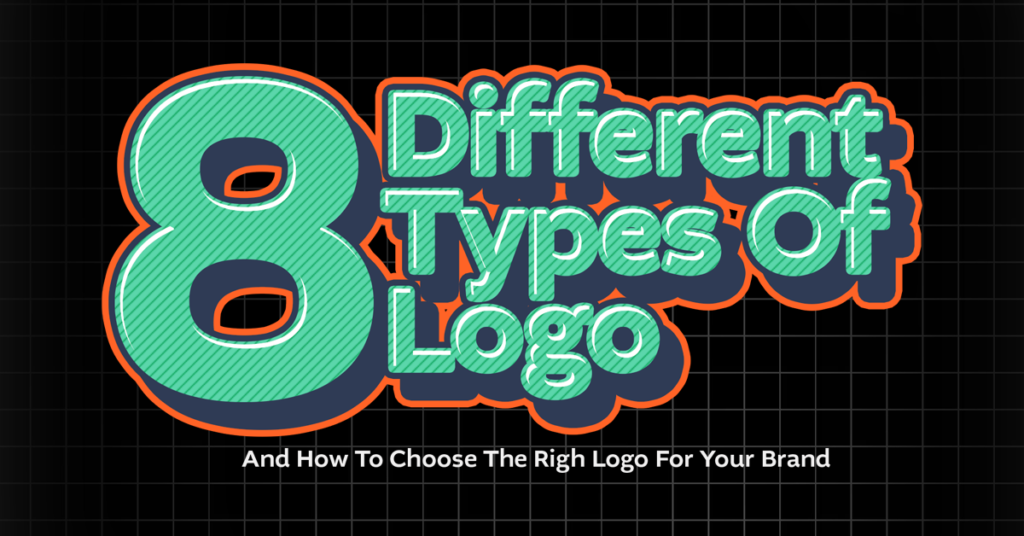Understanding the diverse forms of a logo design is crucial when creating a logo. From a standalone visual symbol to plain text or various combinations of the two, there are eight distinct types of logos. This knowledge will empower you to create an exceptional logo design.
Logos are an integral part of our daily lives, often present in the most unexpected places. Look around you there are logos everywhere. They adorn the top corner of your screen, embellish your bag, and populate many other aspects of your surroundings.
Brand marks, whether they grace the side of a billboard or serve as tiny icons on our smartphones, are a vital asset for every business. They serve as a visual representation of a brand’s identity, distinguishing them from their competitors. A well-crafted logo not only accurately mirrors the brand and its character but also remains memorable and versatile in various contexts.
The 8 types of logos
- Wordmarks/logotypes
- Letterforms
- Letter marks/monogram logos
- Logo symbols/brand marks
- Abstract logo marks
- Emblem
- Mascots
- Combination marks
1. WORDMARK/ LOGOTYPE
If you’re going for a wordmark or text logo, here are a few routes you can take. You can choose a logo font that reflects your brand’s vibe. Modern logo designs, for example, will generally use a sleek font, while trendy logo designs require more elaborate typefaces. Consider whether to go for all caps, small letters, or a mix and add any special characters or colours to your logo. Some brands, like Cadbury, also create a custom typeface, especially for their logo. However, this takes time and requires the skills of a professional designer and commitment to a long graphic design process.
When to use wordmark and logotype logos: A wordmark is a great choice for brands with catchy names or those that want to get their name out into the world, as their logo will appear throughout all their communication and marketing materials.
Examples: Cadbury, Google, Subway, Tata, FedEx and Intel.
2. LETTERFORMS
Generally, letterform logos are a good choice for brands that are already reasonably well-known. Otherwise, it can be tricky getting people to know and remember your company’s name. They’re also beneficial for brands with long names. Large companies can also use them with a lot of visibility as part of rebranding efforts. And if you’re a brand that believes in minimalism, they’re also a good choice.
Letterform logo designs, being small, are easily scalable. Even when used in very small dimensions, they’re likely to stay recognizable, especially if they have a fairly simple design without too many details. This versatility makes them ideal for app icons, favicons, social media profile pictures and more, providing you with a wealth of options for your brand’s visual identity.
Letterforms are one-letter logos that only include the first letter of the company’s name. Often, brands will have an additional version of their logo that comprises their full business name, called a wordmark or logotype, to be used on different occasions.
Examples: Facebook, McDonald’s, Netflix and Pinterest, WordPress and Tesla.
3. LETTERMARKS/MONOGRAMS
Similarly to the logo types mentioned above, lettermarks can also be made using a custom typeface or by finding a font that successfully conveys your brand identity. Make sure to take into account various typography parameters, like kerning (the spacing between letters), width, weight and style (such as bold or italic).
Letter marks (a.k.a. monogram logos) are typography logos that are made up of the brand’s initials. In most cases, brands that have monogram logos are referred to by their abbreviated version when speaking, like HP and ESPN (Do you even know the full form of ESPN?)
In certain industries, it’s commonplace for brands to use the abbreviated version of their name. If you’re operating within those, you may want to stick to the norm and create a lettermark logo. Letter marks are also a common choice for brands with long names that want to be more memorable with a shortened version. Think about your target audience and their need for an abbreviated version they’ll remember. Just make sure to get feedback on your abbreviation to make sure it makes sense and that you have correctly spelt something inappropriate.
Letter marks are also a common choice for brands with long names that want to be more memorable with a shortened version. This memorability factor can give you confidence in your branding choices, knowing that your audience will remember and recognize your brand.
4. LOGO SYMBOLS/BRAND MARKS
These logos are a good choice for companies that want to create a visually appealing and memorable logo. Logo symbols can also be easily recognized and understood by people of all cultures.
If you decide to go for a pictorial mark, consider what will symbolize your brand. Do you want it to be a literal representation of your name, like Apple? It can also be used to suggest your brand’s values or message subtly. For example, how Nike’s logo shows the wing of the Greek goddess, symbolizing speed, movement, power, and motivation
Finding the perfect image for your logo symbol can be a challenge, especially if you’re a fairly new brand. Not only are you likely to grow, change and add new products as time goes on, but it could also take time for customers to recognize your logo and connect it to your brand. In this case, consider incorporating your name into the logo (see combination marks below).
Logo symbols (a.k.a. brand marks or pictorial marks) are graphic icons, symbols or images that reflect the brand’s identity or activity. Normally, these types of logos represent an object from the real world. Some of the best logos using symbols are the kind that you instantly know which brand it is the second you see them.
Examples: Shell, Apple, Twitter, Warner Brothers, Instagram and Snapchat.
Another plus to using these types of logos is that they help set a strong tone of voice. Once your company gains recognition, a well-designed logo symbol can become very memorable.
In addition to making sure you choose a symbol that evolves with your brand, an important logo design tip is to ensure that your design will always remain timeless. While it may be tempting to design a symbol that is trendy and ‘of the moment’, you don’t want to have to create a new logo months later in order to stay current.
5. ABSTRACT LOGO MARKS
As they don’t depict a specific recognizable object, abstract logo marks give you the chance to create something highly unique. If you go for this type of logo, pinpoint your brand’s core values. Experiment with reflecting them in a simple, geometric form that will evoke the right emotions and messages. For example, the three arc form in Spotify’s logo is reminiscent of sound waves, serving as a visual metaphor for Spotify’s mission of connecting people with music.
Examples: Airbnb, Mastercard, Pepsi, Google Drive, Adidas and Spotify.
When to use abstract logo marks: If you decide to create this type of logo, make sure you’ve solidified your brand identity and know exactly what it is that you want to convey to your audience. In addition, an abstract logo mark can be a good choice for global brands whose names need to work better across different languages. Not sure? Consider leading with usability testing to get an idea of how your abstract logotype works with a target audience.
These are image-based logos that use abstract forms to reflect a company’s branding. Unlike pictorial marks that represent a real object, abstract logo marks are more symbolic.
6. MASCOTS
Examples: Michelin, KFC, Pringles, Cheetos and Amul
Mascot logos consist of illustrated characters that act as visual representations or “ambassadors” for a brand. They can be anything from fictitious creatures to real people as long as they reflect the brand’s identity.
Mascots can be a good way of getting customers to connect to your brand, as people tend to resonate with other humans or characters naturally. You can also use a mascot to create a fun, playful vibe that will appeal to your audience, which explains why companies targeting children and families often use this type of logo. Consider whether your business suits having a mascot and, if so, how you can use it to send the right message. Start with, what’s the goal of our logotype? Then, work from there.
Due to their generally friendly, engaging nature, mascots can work well when designing for social media and marketing campaigns. They also work well with animation and other motion effects. However, please take note that they’re often made up of more details than a standard logo so that they may require a simplified version for small dimensions, like favicons or business cards.
7. EMBLEMS
Emblems, also known as badge logos, are typically reminiscent of crests. They combine text and symbolic imagery to form ornate designs with a traditional feel.
When to use emblems: Emblems can also give you the space you need to add a slogan that reflects your brand’s message. When creating an emblem, take into account that due to their intricate details, this type of logo can be less versatile and doesn’t always work well on a smaller scale. In those cases, you can create a simpler alternative.
Examples: Starbucks, Bajaj, Harley-Davidson, Warner Brothers & Manchester United.
If you’re considering whether an emblem is right for your brand, think about the industry you’re in. While there are no rules, this type of logo is especially popular amongst universities, sports teams and coffee brands. A current logo trend is a contemporary take on the emblem, opting for a more minimal approach, which usually involves vector illustrations and clean lines.
8. COMBINATION MARKS
Whichever type of logo you choose, remember that mindful design will not only elevate your brand but ensure that customers will remember your logo in their minds long after. Over time, consumers will build positive associations with your logo and your brand, which ultimately adds value and trust.
Examples: Taco Bell, Toblerone, Dropbox, Rolex and Burger King.
Combination marks are very popular amongst brands from all industries, as they are extremely versatile. You can create a number of variations of your logo and use them for different purposes while ensuring clear and cohesive visual language throughout. For example, notice how Lacoste uses their combination mark on their website design, while most of their products only feature the much-loved and recognizable green crocodile.
This type of logo combines images with words. For example, a combination logo could consist of an icon with a wordmark, or a mascot with a letterform and so on. Some brands have one main logo in the form of a combination mark while occasionally splitting up the text and imagery to better suit various contexts.
For companies that have yet to be well-known, combination marks can be a great starting point, helping you build brand recognition. With time, you’ll have the freedom to use just the text or just the icon while remaining recognizable. Also, supporting the text with icons, symbols, and other forms of imagery helps potential customers understand what your brand is all about.
These were the major 8 different types of logo and their meaning and uses. You can choose whichever kind of logo suits your brand name image or product/service.

